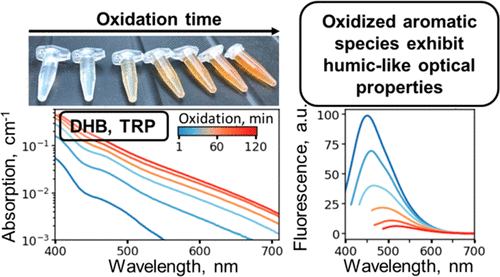Oxidation of Individual Aromatic Species Gives Rise to Humic-like Optical Properties
Boris P. Yakimov, Anna A. Rubekina, Alexander Ya. Zherebker, Gleb S. Budylin, Victor O. Kompanets, Sergey V. Chekalin, Yuri G. Vainer, Afraa A. Hasan, Eugene N. Nikolaev, Victor V. Fadeev, Irina V. Perminova, and Evgeny A. Shirshin
Environ. Sci. Technol. Lett., 2022, , doi: 10.1021/acs.estlett.2c00161

Abstract
The mechanism of formation of the optical properties of dissolved organic matter (DOM) and humic substances (HS) is still a challenging problem in optical spectroscopy and environmental science. Decades of research have formed the list of spectral properties common to DOM and HS, which are impossible to mimic with individual molecular fluorophores and chromophores. Here we show that humic-like optical properties can be reproduced by the heterogeneous systems of chromophores that appear as a result of oxidation of simple aromatic species. To illustrate this fact, features of the steady-state and time-resolved optical response, as well as molecular composition, were studied during the oxidation of tryptophan and dihydroxybenzoic acid in aqueous solutions. The generated mixture of oxidation products exhibited visible absorption and fluorescence almost similar to those of DOM and HS, yet minor discrepancies with an HS-like optical response could be revealed by borohydride reduction and changes in the pH of the studied systems. The suggested generalized framework of the formation of humic-like optical properties can be further extended to other classes of systems and serve as the basis for investigating DOM and HS photophysics on simpler models.
